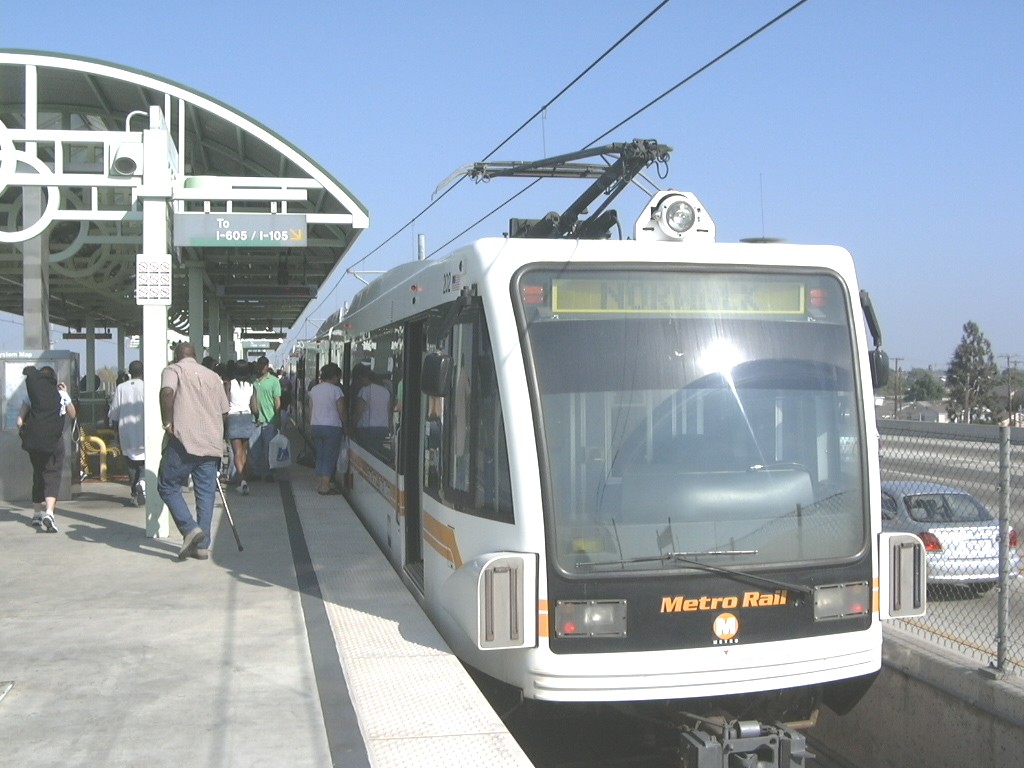 Los Angles Green Line LRT [Photo: L. Henry]
Related Links
Light Rail Now! can be contacted at: Light Rail Now! |
Todd Litman heads the Victoria Transport Policy institute (VTPi) in Victoria, BC, Canada. Whether or not rail transit has a significant impact on urban traffic congestion continues to be an issue of intense debate within the transportation industry and profession. Here is a short summary of the evidence that I find particularly persuasive that rail transit does reduce traffic congestion. My study, Rail Transit in America: Comprehensive Evaluation of Benefits shows that residents in cities with higher quality rail transit systems experience far less per capita congestion delay than residents of cities with inferior transit service. Similarly, detailed analysis of Texas Transportation institute data by Winston and Langer (2004) also indicates that both motorist and truck congestion costs decline in a city as rail transit mileage expands, but congestion costs increase as bus transit mileage expands. This appears to occur because buses attract fewer travelers from driving, contribute to traffic congestion themselves, and have less positive impact on land use accessibility.
Baum-Snow and Kahn (2005) found significantly lower average commute travel times in areas near rail transit than in otherwise comparable locations that lack rail, due to the relatively high travel speeds of grade-separated transit compared with commuting by automobile or bus under the same conditions.
Nelson, et al (2006) used a regional transport model to estimate Washington DC transit system benefits to users, and congestion-reduction benefits to motorists. They found that rail transit generates congestion-reduction benefits that exceed rail subsidies, and the combined benefits of rail and bus transit significantly exceeds total transit subsidies. Their study overlooked other benefits such as parking cost savings, crash and emission reduction benefits, and so understates total social benefits. It is important to be cautious about the type of analysis used, including how congestion is measured. Most current traffic models are not very sensitive to congestion feedback and congestion equilibrium (the tendency of congestion to discourage additional trip taking) and so are not very good at discerning the congestion reduction effects of grade-separated transit, and many measure congestion impacts based on roadway Level of Service (LOS), which evaluates the intensity of congestion delay on a particular roadway, and so only takes into account congestion delays to motorists, ignoring the congestion reduction that occurs when people shift mode or when more accessible land use patterns reduce travel distances. For example, if due to the development of high-quality, grade-separated transit service in your community you avoid congestion by shifting from driving to transit commuting, the benefit to you is not measured by many models. Similarly, if a transit station creates an urban village where you can walk rather than drive to run more errands, such as picking up a DVD or taking your children to school, the resulting congestion reduction does not show up when impacts are measured as LOS. For further information see: Nathaniel Baum-Snow and Matthew E. Kahn, "The Effects of Urban Rail Transit Expansions: Evidence from Sixteen Cities," 1970 to 2000, Brookings Papers on Urban Affairs (www.econ.brown.edu/fac/Nathaniel_Baum-Snow/brook_final.pdf), 2005. Thomas A. Garrett and Molly D. Castelazo, "Light Rail Transit in America: Policy issues and Prospects for Economic Development," Federal Reserve Bank of St. Louis (www.stlouisfed.org), 2004. David Lewis and Fred Laurence Williams, "Policy and Planning as Public Choice: Mass Transit in the United States," Ashgate (Aldershot; www.ashgate.com), 1999. Todd Litman, "Rail Transit in America: Comprehensive Evaluation of Benefits," VTPI (www.vtpi.org), 2004. Todd Litman, "Evaluating Public Transit Benefits and Costs: Best Practices Guidebook," VTPI (www.vtpi.org), 2005. Peter Nelson, Andrew Baglino, Winston Harrington, Elena Safirova and Abram Lipman, "Transit in Washington, D.C.: Current Benefits and Optimal Level of Provision," Resources for the Future (www.rff.org/rff/Documents/RFF-DP-06-21.pdf), 2006. Clifford Winston and Ashley Langer, "The Effect of Government Highway Spending on Road Users' Congestion Costs," Brookings institute (www.brookings.edu), 2004. Light Rail Now! website URL: http://www.lightrailnow.org/features/f_lrt_2006-06a.htm Updated 2006/06/03 |
|
|
|
||